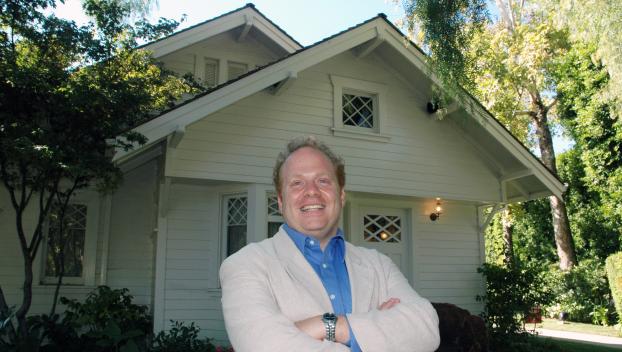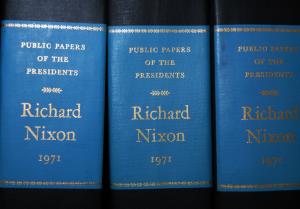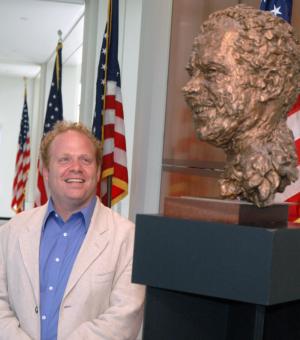 Caption: Scott J. Spitzer stands in front of Richard Nixon's childhood home, located at the Nixon Library and Museum in Yorba Linda. Photo by Patrick O'DonnellDownload Photo
Caption: Scott J. Spitzer stands in front of Richard Nixon's childhood home, located at the Nixon Library and Museum in Yorba Linda. Photo by Patrick O'DonnellDownload Photo
The New Nixon Library
Research and Teaching Resources Available at Presidential Archive
In 2007, the Richard M. Nixon Library and Birthplace in Yorba Linda came under the management of the National Archives and Records Administration, the 12th member of the system of presidential libraries. Renamed the Richard M. Nixon Library and Museum, its transition from a privately funded entity to a federal facility has been long and challenging.
The presidential library system that FDR inaugurated in 1939 with the founding of his Hyde Park presidential library and museum, is a quintessentially American institution for memorializing the nation’s past. Presidential libraries are both research facilities and places to memorialize our presidents. In many ways, these two roles operate parallel to one another, but entirely separate.
Prior to FDR, it was assumed that all presidents owned their archival records — some cared for them and preserved them for posterity, some sold them, and many of their records — for example, President Van Buren’s — were destroyed. Roosevelt’s decision to donate his papers to the National Archives and establish a private museum on his Hyde Park estate marked the beginning of the private/public partnership model that continues to shape the presidential library system. Subsequent presidents have donated both their papers and a “library” to the NARA, which manages the papers and makes them available to the public in accordance with the terms of a deed of gift from the president.
This system prevailed until 1974 when, in the immediate aftermath of his resignation following disclosures of his complicity in the Watergate cover-up, the distinct possibility that former President Nixon would destroy sensitive records, including many of the White House tapes, motivated Congress to seize those materials and mandate their retention by NARA, inside the jurisdiction of the Washington, D.C., metropolitan area.
The resulting Presidential Recordings and Materials Preservation Act of 1974 ensured that the NARA would govern these materials and their processing. The law required NARA to return to President Nixon any materials that were of a “personal and private nature,” including those documents that were solely political, with no content related to the conduct of the president’s official or Constitutional duties.
Under these provisions, President Nixon successfully sued to have 150,000 pages of his personal and political records returned to him. A large portion of these contested or returned documents — 78,000 pages — were returned to NARA as part of its transition agreement with the private Nixon Foundation, and on the day that the “new” Nixon library opened under the auspices of NARA — July 11, 2007 — these contested or returned documents were opened for public access.
Appointed in 2006 to lead the institution during its reorganization, Director Timothy Naftali is an accomplished historian whose own research makes extensive use of archival resources — an ideal choice to manage access to the White House tapes, the most controversial and perhaps most exciting historical record of the Nixon administration.

Caption: Among the many papers in the revamped Nixon Library are the late president's speeches. Photo by Patrick O'Donnell
More than 46 million pages of textual presidential materials are accessible for research in the $7.3 million storage facility, which the Nixon library completed in 2009. While the originals remain in the National Archives in Washington, D.C., digital copies of 2,017 hours of those tapes are available at the library, along with millions of feet of motion picture film, hundreds of thousands of photographs and thousands of videotapes.
Since 2007, Naftali has overseen the release of thousands of previously unavailable textual records and the first release of hundreds of hours of White House tapes since processing was halted in 2003. As a result of his leadership, the most politically sensitive of these contested records — the White House Special Files records in this collection — are now accessible in their entirety online.
Naftali is moving aggressively to speed the processing of the remaining document collections and tape recordings as well.
While access to the unique archival records of the modern presidents is of great interest to political scientists and historians, the associated presidential libraries are located all over the nation, and bring in millions of the public annually to view their museum exhibits.
While nearly all of the presidential library foundations promote a memorial approach to their respective presidents, the skewing of history under prior leadership of the Nixon library was particularly egregious, including an exhibit that portrayed Watergate as a plot carried out by the Democrats.
Naftali oversaw the closing of that exhibit and erection of the new, permanent Watergate exhibit, relying on digital video of oral history interviews that he has conducted with former members of the Nixon administration and others directly involved in those events. As Naftali continues to expand the archival resources available for research and develop a diverse and strong program of public events and museum exhibits, the Nixon library will indeed be an exciting place for scholars and their students to be in the coming years.
A longer version of this article first appeared in the spring 2010 issue of The Western, the Western Political Science Association's newsletter. Scott J. Spitzer is an assistant professor of political science.
Dec. 14, 2010
 Scott J. Spitzer and a bas relief of Nixon. Photo by Patrick O'Donnell
Scott J. Spitzer and a bas relief of Nixon. Photo by Patrick O'Donnell 